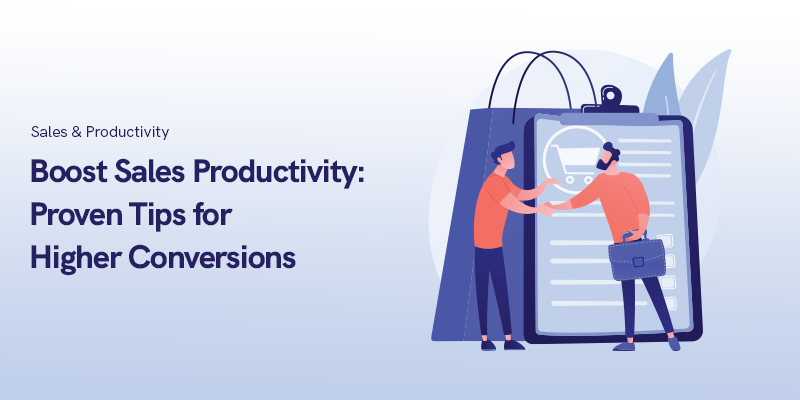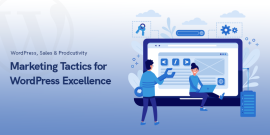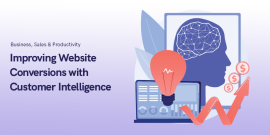
Boost Sales Productivity in 2023: Proven Tips for Higher Conversions
Lead conversion plays a pivotal role in driving growth, increasing sales, and ultimately, achieving long-term success in any business.
To help you navigate this important aspect of your business, we have compiled proven tactics from the latest website design strategies to advanced marketing techniques in order to equip you with the necessary tools to engage, nurture, and convert leads and maximize your revenue potential.
Please make sure not to skip any steps as each part can play an essential role in the success of your marketing strategy as a separate piece of the puzzle.
Website Design
Conversions are critical to your business as they determine how effective you are acquiring new customers.
While there are several ways to increase your online conversion rates, one of the most effective approaches is to improve the design of your website.
Keep It Simple and Professional
Create a clean and visually appealing design that enhances user experience. Simplify navigation by removing unnecessary elements such as extra menus, pop-ups, and sidebars.
Optimize for Speed and Mobile Users
Improve page load time, especially for mobile users, as even a one-second delay can significantly reduce conversion rates.
Utilize techniques like hosting custom fonts from a CDN, optimizing images, and limiting the use of animations.
Utilize Negative Space
Use negative space effectively to create an organized and easy-to-scan layout.
Incorporate blank space to declutter your website and guide users' attention towards important information and call-to-action buttons.
Consider the F-layout
Structure your content according to the F-pattern, as research shows users tend to scan web pages in an F-shaped pattern.
Place important content, visuals, and call-to-action buttons along the F-shaped lines to capture users' attention.
Carefully Choose the Color Schemes
Select an appropriate color scheme that aligns with your brand and evokes the desired emotions from visitors. Use contrast to make headlines, texts, and call-to-action buttons stand out.
Leverage the Rule of Thirds
Divide your landing page into thirds horizontally and vertically using the rule of thirds.
Place valuable content such as testimonials, headlines, and offers in the four corners of the central square to attract users' attention.
Employ the 8-Second Rule
The average site visitor has an attention span of 8 seconds, so try to capture visitors' interest within the first 8 seconds by using compelling headlines, clear call-to-action buttons, engaging content, and interactive elements like videos or animations.
Implement the Gestalt Similarity Principle
The Gestalt similarity principle allows you to take advantage of how humans perceive objects by grouping items you want your site’s visitors to associate with one another.
For example, place testimonials near your call-to-action button to create a sense of trust and encourage action.
Introduce an Achievement Counter
showcase your achievements and milestones using numbers and facts. Displaying captivating percentages or business capabilities that can attract more clients and instill confidence in your offerings.
Incorporate Faces Into Your Pages
Use images with human faces to create an emotional connection between your products/services and visitors.
This can evoke positive empathy and make visitors more inclined to desire similar experiences.
Integrate Social Media in Email Marketing
Social media has helped capitalistic giants sound more human through branding and brand voice. In a world where brands are expected to be global but sound local, social media has given them the power to sound relatable and quirky.
Leveraging social media ultimately helps you gain higher customer engagement, higher monetary ROI, and an increased probability to be seen and discovered, i.e., brand awareness.
Let’s see how to use social media to improve conversion rates:
Cross-Linking Your Social Media and Your Email
Combine social media and email marketing to maximize their benefits.
Include links to your social media profiles in your emails to allow users to engage with your brand before making a decision.
Coordinate social media posts with email campaigns to drive engagement and sales.
Adding Social Media Feeds in Your Emails
Incorporate live social media feeds in your emails to provide dynamic content that can be easily shared and amplified.
Including user-generated content and testimonials from social media can build trust and credibility.
Loyal Subscribers to Loyal Customers to Brand Evangelists
Reward your most engaged email subscribers by inviting them to join exclusive social media communities or groups.
Encourage active customers to spread the word about your brand and engage with others, turning them into brand evangelists.
Giveaways for Building Targeted Email Lists
Use giveaways on social media to incentivize followers to subscribe to your email newsletter.
This helps build a targeted email list and increases engagement. Ensure you validate email addresses to maintain a high-quality subscriber base.
Promote Social Channels Through Email Newsletters and Vice Versa
Leverage your existing email newsletter subscribers to promote your social media channels.
Include links to your social media profiles or pages in your emails. Additionally, promote your email newsletters on social media to generate valuable leads.
Jazz Up your Subject Lines With Personalization
“Personalization—it is not about first/last name. It’s about relevant content.” – Dan Jak
Personalize your email subject lines to increase open rates. Use relevant content, company names, transaction history, FOMO (fear of missing out), or location-specific information to make subject lines more engaging and personalized.
Email CTAs
The primary objective of any email campaign is to get people to take action.
As important as it is to have a compelling subject line and an engaging copy to go with it, the CTA holds equal significance.
If your CTA is not placed properly or is not clearly visible, your emails would not get clicked-through, and ultimately, it will hamper your campaign performance.
Through this article, we shall shed light on how you can design and place your CTAs to drive maximum click-through rates and conversions.
Place It in the first fold of the email to draw instant attention
Positioning the CTA above the fold ensures that it is easily visible to subscribers and draws their attention.
Have a single CTA that fulfills the purpose of the email
Define a clear objective for your email and create a CTA that aligns with that objective.
Using actionable language and incorporating a sense of urgency can be effective.
Use plenty of white space around the CTA
Adding ample white space around the CTA enhances readability and helps grab the subscriber's attention.
It also ensures that the CTA is easily tappable, especially for mobile users.
Write the CTA in first-person narrative
Using a conversational tone and framing the CTA from the subscriber's perspective can improve its effectiveness and conversion rates.
Ensure the CTA button is tappable on mobile devices
With a significant number of subscribers accessing emails on mobile devices, it is crucial to design CTA buttons that are at least 44×44 pixels in size for easy tapping.
Use innovations in CTA design
Experiment with creative ideas for CTA copy and design to make it more enticing.
Using unique language, hover effects, animations, or other interactive elements can make the CTA stand out.
Link the CTA to a relevant landing page
Ensure that the CTA directs subscribers to a landing page that provides more details about the offer or promotion mentioned in the email. Avoid redirecting them to the homepage.
A/B test and optimize the CTA button
Conduct split testing to compare different versions of the CTA button and identify the one that generates the highest click-through rate and conversions. Optimize the CTA based on the test results.
Social Listening
Social media provides access to millions of conversations, allowing marketers to gain insights into their customer base and understand what they want from brands.
Social listening helps bridge the gap between businesses and their audience.
Identify customer pain points
Monitoring negative feedback and complaints on social media allows businesses to understand customer frustrations.
By engaging with customers and addressing their concerns, businesses can display empathy and potentially generate new campaigns to alleviate fears and improve customer satisfaction.
Studying Your Competitors
Tracking competitors through social media provides valuable insights into the sentiment surrounding their brand.
Analyzing metrics such as “share of voice” helps understand the volume of activity and engagement related to competitors.
This information can guide marketers in developing strategies to compete effectively.
Automate your listening
Setting up alerts and notifications enables real-time monitoring of conversations related to the brand, including variations in spelling and keywords.
Automating social listening helps businesses stay responsive and avoid missing important discussions.
Tools like Agorapulse and TweetDeck can assist in automating social media alerts.
Tracking effectiveness
It is essential to track the effectiveness of interactions and engagements resulting from social listening.
Analytics platforms like Google Analytics and Finteza help measure traffic sources and evaluate on-site engagement driven by social media efforts.
A/B Testing
A/B testing allows businesses to compare two versions of a webpage and determine which one performs better in terms of engaging audiences and increasing conversions.
It provides iterative insights for optimizing website design decisions and is commonly used by digital marketers to enhance customer satisfaction.
Identifying the goals of an A/B Test
Before conducting an A/B test, it is important to clearly define the purpose and goals of the test.
This helps establish benchmarks and guides decision-making based on the results.
Marketing automation tools, like Act-on software, integrate A/B testing to identify improvement areas and track the success of new initiatives.
Selecting the right metrics
Choosing the right metrics to measure the outcomes of an A/B test is crucial.
It is necessary to determine what success looks like and select relevant indicators such as website session times, user engagement, or clicks.
Establishing a baseline for these metrics before the test provides valuable data points for comparison.
Designing a testable hypothesis
Crafting a clear and achievable hypothesis is essential for an A/B test. Breaking down goals into measurable and attainable objectives helps measure success and make improvements over time.
A detailed hypothesis covers critical aspects of the A/B test goals and ensures accurate results.
Creating multiple variations
A/B testing involves creating multiple versions of content to test which one appeals better to the target audience.
Comparing different variations helps understand what works best and informs long-term marketing strategies.
It is important to keep the differences between variations small enough for accurate measurement.
Collecting and analyzing data
Gathering relevant and reliable data is crucial for data-driven insights. A/B testing allows businesses to collect data on customer engagement and the performance of different segments.
Analyzing the data uncovers new opportunities and informs decision-making based on facts, increasing the chances of conversion optimization success.
Increase Sales Productivity
Sales productivity refers to how efficiently and effectively a salesperson can produce their output.
The more efficient a salesperson is, the more sales productivity can be delivered to a certain campaign.
Assessing sales efficiency is important for the efficacy of sales conversion as they steadily move the buyers towards their purchasing decision.
Make prospecting your priority
Focus on researching potential customers who can benefit from your product or service.
Use cold email automation, LinkedIn research, and cold calling to connect with prospects.
Work with quality leads and nurture them
Prioritize working with high-quality leads and develop a scoring system to assess their readiness to buy.
Nurture leads by demonstrating the value of your offering.
Sound like a local salesperson
Build rapport with potential customers by speaking their language and emphasizing the benefits of your product or service.
Avoid technical jargon and focus on how your offering can help them achieve their goals.
Provide continuous sales training and coaching
Provision of training development for sales representatives is something that is implemented by enterprise companies.
It is to make sure that their agents are equipped with updated product knowledge to make better sales pitch for their prospects.
Ongoing training on trending sales strategies should also be included in the sales training program to enhance your sales agent’s talent in sales tracking software, tools and closing techniques.
Communicate daily with team members
“Communication is the key” is a common phrase for any organization that wants to build their business with as much transparency.
Foster open communication among your sales team, sharing successful techniques and addressing challenges. Celebrate small wins and acknowledge individual efforts.
Send a more personalized email
An automated email is good but when you are working with your sales prospects, personalized email is your get-go.
Instead of relying solely on automated emails, personalize your communication with prospects.
Craft subject lines and headers that grab attention and send friendly reminders about relevant events or holidays.
Evaluate your sales tools
One common mistake a company makes is they do not evaluate their tools; whether it is working for them or not.
Regularly assess the effectiveness of your sales tools and technologies. Consider using integrated A/B testing tools and CRM integrations to optimize your campaigns and track results.
Set expectations early with your leads
A steady flow of leads does not always mean revenue. Sadly, almost half of your acquired leads are not fit for your business.
Clearly define the next steps in the sales process and establish a specific date, meeting, and agenda with your prospects.
Encourage them to take action, such as scheduling a demo or subscribing to newsletters.
Utilize your sales automation with CRM integrations
Scaling sales conversion is not possible without sales automation. A sales automation is only as good as the quality and variety of data it automates.
Leverage sales automation and CRM tools to organize and manage your leads effectively.
Automate reminders, follow-ups, and other CRM events to streamline the sales process.
Follow-up with SMS campaigns
Since SMS is starting to become mainstream business communication, you can utilize this underrated channel and to do this, create an SMS marketing campaign to boost your response rate in real-time conversations with your customers.
Send your lead constant reminders about their business with you. Keep in mind that commercial text messaging is also regulated by federal laws.
Spam text messages are not an option to bombard your customers’ inboxes.
Broaden your social networks
Just sticking to your niche industry is a good foundation to build your social circle.
You should also connect with other industries that might be interested in your business.
You can also get mentions and invites from major industry players. Social networking presents a great opportunity for your business to get recognized. Follow your competitors’ channels and see who connects to them and work your way up.
Create abandoned email campaigns
On your sales agent’s downtime, they can make time in creating a separate email outbox for abandoned email sent-outs.
You can revisit unresolved and unresponsive emails to evaluate what could have been done.
If the email has not opted out yet, you can organize a re-engagement campaign for them. Of course, there is little return in this endeavor.
Localize your CTAs
Localizing CTAs does not mean using geographical location but making your CTAs more specific and attractive to solving their problems.
Lessen your open-ended questions for CTAs as it does not solicit a specific action from your prospective customers.
CTAs can be strategically placed on multiple segments of your message, blogs, or proposals. It does not necessarily have to be at the bottom of your pitch.
Provide shorter forms
In sales and marketing, one of the objectives is to reduce the lead’s hesitation to fill out a form.
The shorter the form, the lesser time it takes to complete. It allows your lead to provide their information quicker.
For starters, you can ask their full name, company, and email address. You can then ask the additional questions after you make a few engagements with them.
Personalization
We all know that our website's success is highly dependent on the number of people we get to visit it, no matter if it's a blogging site or an online store.
Even small changes, such as modifying banners or call-to-action buttons, can have a significant impact on lead generation and sales.
Technically speaking, two main factors grow your website and keep the audience interested in your content: low bounce rate and high conversion rate.
The lower the bounce rate of your site is, the higher its conversion rate will become. With the increased competition in the online world, an underperforming website will have no chance to succeed in sales and conversions.
Personalization involves dynamically adapting content based on individual visitor characteristics, while customization gives control to the users.
Personalization goes beyond the website and utilizes data from various sources to create a tailored experience.
Contact Details
Displaying contact information prominently, including various means of support like email, phone, live chat, and contact forms, helps personalize the website and build trust with visitors.
If the business operates in different locations, mentioning the local presence can entice visitors from those areas.
Images and Content
Personalizing images and publishing engaging content based on visitors' interests helps establish a deeper connection.
Valuable content should be shown to the right audience, and infographics, product photos, and promotion banners should be personalized.
Customer Testimonials
Displaying personalized customer testimonials can increase their impact on users.
Sharing testimonials from users in specific areas or demographics adds credibility and builds trust.
Product Details and CTAs
Personalize product descriptions and call-to-action (CTA) buttons to cater to specific regions, age groups, or other conditions.
Adding variety to the design, colors, and layout of CTAs helps make them more effective and keeps the user's focus.
Geographical Location
Changing content based on visitors' geographical location helps provide relevant information.
Geotargeting tools can be used to personalize images and texts based on the visitor's location
Time and Device Personalization
Showing unique content based on the time of day, month, or year can increase conversions.
Additionally, tailoring content to the device being used (e.g., mobile or desktop) helps improve the user experience and reduce bounce rates.
Recommended Posts

Top 6 Free Windows Screen Recorders for Your Personal Blog
February 8, 2024

Marketing Tactics for WordPress Excellence in 2024
January 22, 2024

Improving Website Conversions with Customer Intelligence
December 24, 2023
This was a nice article thank you for writing it.